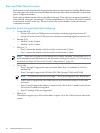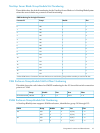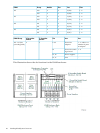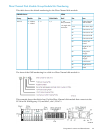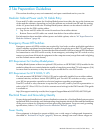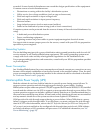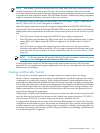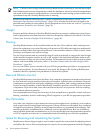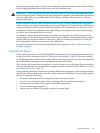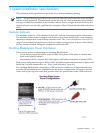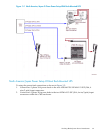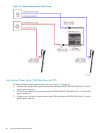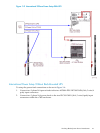
NOTE: Failure of site cooling with the NonStop BladeSystem continuing to run can cause rapid
heat buildup and excessive temperatures within the hardware. Excessive internal temperatures
can result in full or partial system shutdown. Ensure that the site’s cooling system remains fully
operational when the NonStop BladeSystem is running.
Because each modular cabinet houses a unique combination of enclosures, use the “Heat
Dissipation Specifications and Worksheet” (page 50) to calculate the total heat dissipation for
the hardware installed in each cabinet. For air temperature levels at the site, refer to “Operating
Temperature, Humidity, and Altitude” (page 50).
Weight
Because modular cabinets for NonStop BladeSystems house a unique combination of enclosures,
total weight must be calculated based on what is in the specific cabinet, as described in “Modular
Cabinet and Enclosure Weights With Worksheet ” (page 49).
Flooring
NonStop BladeSystems can be installed either on the site’s floor with the cables entering from
above the equipment or on raised flooring with power and I/O cables entering from underneath.
Because cooling airflow through each enclosure in the modular cabinets is front-to-back, raised
flooring is not required for system cooling.
The site floor structure and any raised flooring (if used) must be able to support the total weight
of the installed computer system as well as the weight of the individual modular cabinets and
their enclosures as they are moved into position. To determine the total weight of each modular
cabinet with its installed enclosures, refer to “Modular Cabinet and Enclosure Weights With
Worksheet ” (page 49).
For your site’s floor system, consult with your HP site preparation specialist or an appropriate
floor system engineer. If raised flooring is to be used, the design of the NonStop BladeSystem
modular cabinet is optimized for placement on 24-inch floor panels.
Dust and Pollution Control
NonStop BladeSystems do not have air filters. Any computer equipment can be adversely affected
by dust and microscopic particles in the site environment. Airborne dust can blanket electronic
components on printed circuit boards, inhibiting cooling airflow and causing premature failure
from excess heat, humidity, or both. Metallically conductive particles can short circuit electronic
components. Tape drives and some other mechanical devices can experience failures resulting
from airborne abrasive particles.
For recommendations to keep the site as free of dust and pollution as possible, consult with your
heating, ventilation, and air conditioning (HVAC) engineer or your HP site preparation specialist.
Zinc Particulates
Over time, fine whiskers of pure metal can form on electroplated zinc, cadmium, or tin surfaces
such as aged raised flooring panels and supports. If these whiskers are disturbed, they can break
off and become airborne, possibly causing computer failures or operational interruptions. This
metallic particulate contamination is a relatively rare but possible threat. Kits are available to
test for metallic particulate contamination, or you can request that your site preparation specialist
or HVAC engineer test the site for contamination before installing any electronic equipment.
Space for Receiving and Unpacking the System
Identify areas that are large enough to receive and to unpack the system from its shipping cartons
and pallets. Be sure to allow adequate space to remove the system equipment from the shipping
34 Site Preparation Guidelines



